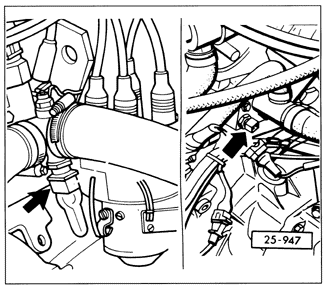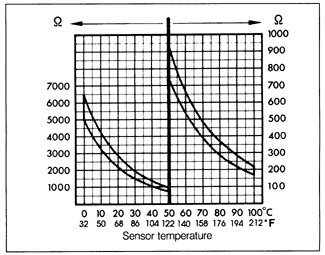After-start and Cold Running EnrichmentTo ensure smooth running, the system supplies additional fuel to a cold engine by increasing differential pressure regulator current for a short period after starting and during warm-up. A coolant temperature sensor provides the control unit with temperature information. The starter provides an additional signal for after-start enrichment. After-start enrichment lasts approximately 40 seconds. Cold running enrichment decreases gradually as the engine warms up, finally reaching the normal warm running value. To test either function, remove the harness connector from the coolant temperature sensor to simulate a cold engine, as shown in Fig. 6-36. To check cold running enrichment, turn the ignition on. Differential pressure regulator current should be 80 to 100 mA on 16-valve engines, and 80 to 110 mA on all other engines. After-start enrichment is checked after operating the starter. To prevent the engine from starting during the test, disconnect the ignition coil wire from the center of the distributor cap and use a jumper wire to connect it to ground. Actuate the starter for 2 to 3 seconds, then leave the ignition on. The differential pressure regulator current should increase to more than 120 mA for 20 to 50 seconds and then return to the cold running value given above. On 16-valve engines, the after-start enrichment lasts slightly longer (30 to 60 sec.). When the test is complete, turn the ignition off. Reconnect the coil wire and the coolant temperature sensor harness connector.

Test the coolant temperature sensor by detaching its harness connector and checking resistance across the sensor's terminals. The correct resistance varies with engine coolant temperature. A sensor with resistance not corresponding to the values given in the chart in Fig. 6-37 is faulty and should be replaced. When replacing the sensor, drain and refill the engine coolant as described in COOLING SYSTEM.

|